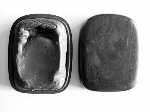Shanxi Chengni Ink slab
Last but not least are chengni ink slabs, produced inXinjiangCounty, Shanxi Province in northern China. They differ from most other ink slabs because of the production methods. Instead of using a big chunk of hard rock, the stone is made from the soft soil from local riverbeds.

Chengni ink slabs originated in the Tang Dynasty (618-907) and were then a precious tribute item. Unfortunately by theQing Dynasty(1644-1911), the craft of kilning the once famous chengni ink slabs had already been lost for various reasons. It has regained its past prosperity after unremitting effort by craftsmen in recent years.
The very fine mud under the bed of the Fenhe River is filtered, mixed with binding material, dried and carved into ink slabs, then fired in the kiln. Because of the different minerals in the mud and also the different temperatures used in firing, the final products have different colors. The process has nine steps: mud selection, filtrating, depositing, molding, baking, carving, firing, waxing and polishing. chengni ink slabs have the following characteristics: they generate ink easily, they don't harm the brush, and they are portable.
In terms of artistic design, chengni ink slabs now come in about a hundred different designs, with stress on patterns and shapes, using elegant and simple but beautiful colors.
Author: Jeff










